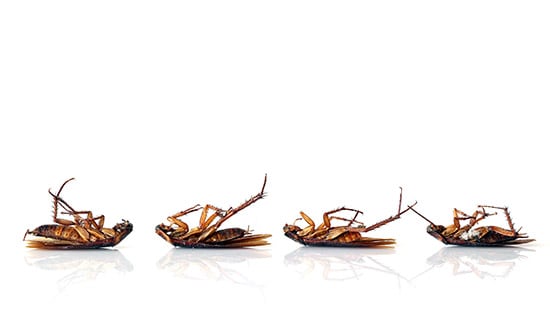The German Cockroach
The Pest Monitor Newsletter

- At 1/2-inch long, is the smallest of all common cockroaches.
- Has two dark-colored parallel lines running from the top of the head to front of the wings.
- Has fully developed wings but does not fly.
- Prefers warm, moist environments—hiding in dark areas by day and foraging for food at night.
- Is omnivorous, scavenging for any food, but shows a preference for starches, sweets, grease, and meats.
- Can live up to seven months.
There are more than 4,000 species of cockroaches worldwide, with about 55 species found in the U.S. Fewer than 10 of these are common pests. Breaking it down further, the cockroach species most likely to infest your food facility is primarily dependent on your geographic location. But no matter where you are in North America, the tiny German cockroach will be a potential—and a very serious—pest.
Because of its small size, (it is only about 1/2-inch in length); propensity to gather in hidden places (e.g., behind walls, in packaging), and prodigious rate of reproduction, the German cockroach can invade without notice and build up into an infestation in a short time.
Food facilities are particularly susceptible to German cockroach infestations, not only because of the constant availability of food, but because many plants have a warm, moist environments in which the German cockroach thrives. Additionally, during its lifetime, one female cockroach can produce more than 350 eggs. And, unlike other species, the German cockroach protects her young by carrying the egg case with her until the nymphs are ready to hatch, enabling a greater rate of survival and maturity to adult.
THE PROBLEM.
The German cockroach has been implicated in the transmission of numerous foodborne diseases including:
- Salmonellosis – Salmonella food poisoning causes diarrhea, fever, and abdominal cramps within 12 to 72 hours.
- Staphylococcus infections – This gastrointestinal illness develops soon after food is eaten and usually lasts about a day.
- Escherichia coli (E. coli) bacteria, which has been found on the cuticle and gut of cockroaches, can cause serious illness in humans.
- Typhoid fever – This life-threatening illness is caused by Salmonella Typhi. When a contaminated food is consumed, the bacteria multiply and spread into the bloodstream.
- Gastroenteritis – Inflammation of the stomach and small and large intestines, generally leading to vomiting or diarrhea.
- General diarrhea.
THE SOLUTION.
German cockroaches are generally carried into food facilities with deliveries of incoming goods or supplies, or even employee belongings. Thus, prevention is the key to keeping cockroaches out and eliminating them at the first sign of their presence:
Inspection. Check all incoming goods for any sign of cockroach presence and refuse those that show any evidence of contamination.
Sanitation. Limit pest access to food and water by maintaining a regular and thorough sanitation program:
- Keep garbage areas clean; repair leaky faucets and pipes; and clean drains.
- Review the Master Sanitation Schedule regularly and see if it still meets the needs of the facility.
- Regularly deep clean the breakroom and locker rooms; check for clutter and food debris.
- Inspect interior equipment graveyards: How often is de-commissioned equipment checked for organic buildup and set on a regular sanitation schedule for inspection?
Exclusion. Repair and seal gaps and cracks through which pests can enter or in which they can harbor.
Notification. If you see cockroaches or other pests, notify your pest service company right away.


